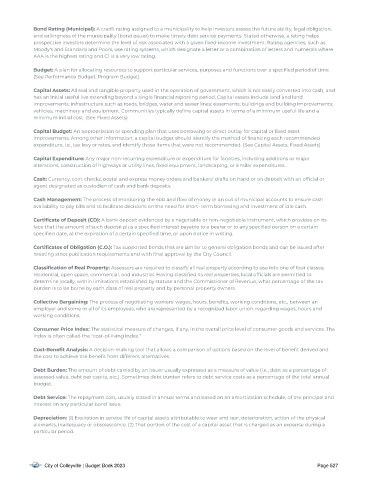Page 527 - CityofColleyvilleFY23AdoptedBudget
P. 527
Bond Rating (Municipal): A credit rating assigned to a municipality to help investors assess the future ability, legal obligation,
and willingness of the municipality (bond issuer) to make timely debt service payments. Stated otherwise, a rating helps
prospective investors determine the level of risk associated with a given xed-income investment. Rating agencies, such as
Moody's and Standard and Poors, use rating systems, which designate a letter or a combination of letters and numerals where
AAA is the highest rating and C1 is a very low rating.
Budget: A plan for allocating resources to support particular services, purposes and functions over a speci ed period of time.
(See Performance Budget, Program Budget)
Capital Assets: All real and tangible property used in the operation of government, which is not easily converted into cash, and
has an initial useful live extending beyond a single nancial reporting period. Capital assets include land and land
improvements; infrastructure such as roads, bridges, water and sewer lines; easements; buildings and building improvements;
vehicles, machinery and equipment. Communities typically de ne capital assets in terms of a minimum useful life and a
minimum initial cost. (See Fixed Assets)
Capital Budget: An appropriation or spending plan that uses borrowing or direct outlay for capital or xed asset
improvements. Among other information, a capital budget should identify the method of nancing each recommended
expenditure, i.e., tax levy or rates, and identify those items that were not recommended. (See Capital Assets, Fixed Assets)
Capital Expenditure: Any major non-recurring expenditure or expenditure for facilities, including additions or major
alterations, construction of highways or utility lines, xed equipment, landscaping, or similar expenditures.
Cash: Currency, coin, checks, postal and express money orders and bankers’ drafts on hand or on deposit with an of cial or
agent designated as custodian of cash and bank deposits.
Cash Management: The process of monitoring the ebb and ow of money in an out of municipal accounts to ensure cash
availability to pay bills and to facilitate decisions on the need for short- term borrowing and investment of idle cash.
Cer ti{cate of Deposit (CD): A bank deposit evidenced by a negotiable or non-negotiable instrument, which provides on its
face that the amount of such deposit plus a speci ed interest payable to a bearer or to any speci ed person on a certain
speci ed date, at the expiration of a certain speci ed time, or upon notice in writing.
Cer ti{cates of Obligation (C .O.): Tax supported bonds that are similar to general obligation bonds and can be issued after
meeting strict publication requirements and with nal approval by the City Council.
Classi{cation of Real Proper ty: Assessors are required to classify all real property according to use into one of four classes:
residential, open space, commercial, and industrial. Having classi ed its real properties, local of cials are permitted to
determine locally, within limitations established by statute and the Commissioner of Revenue, what percentage of the tax
burden is to be borne by each class of real property and by personal property owners.
Collective Bargaining: The process of negotiating workers' wages, hours, bene ts, working conditions, etc., between an
employer and some or all of its employees, who are represented by a recognized labor union. regarding wages, hours and
working conditions.
Consumer Price Index: The statistical measure of changes, if any, in the overall price level of consumer goods and services. The
index is often called the "cost-of-living index."
Cost-Bene{t Analysis: A decision-making tool that allows a comparison of options based on the level of bene t derived and
the cost to achieve the bene t from different alternatives.
Debt Burden: The amount of debt carried by an issuer usually expressed as a measure of value (i.e., debt as a percentage of
assessed value, debt per capita, etc.). Sometimes debt burden refers to debt service costs as a percentage of the total annual
budget.
Debt Ser vice: The repayment cost, usually stated in annual terms and based on an amortization schedule, of the principal and
interest on any particular bond issue.
Depreciation: (1) Expiration in service life of capital assets attributable to wear and tear, deterioration, action of the physical
elements, inadequacy or obsolescence. (2) That portion of the cost of a capital asset that is charged as an expense during a
particular period.
City of Colleyville | Budget Book 2023 Page 527

